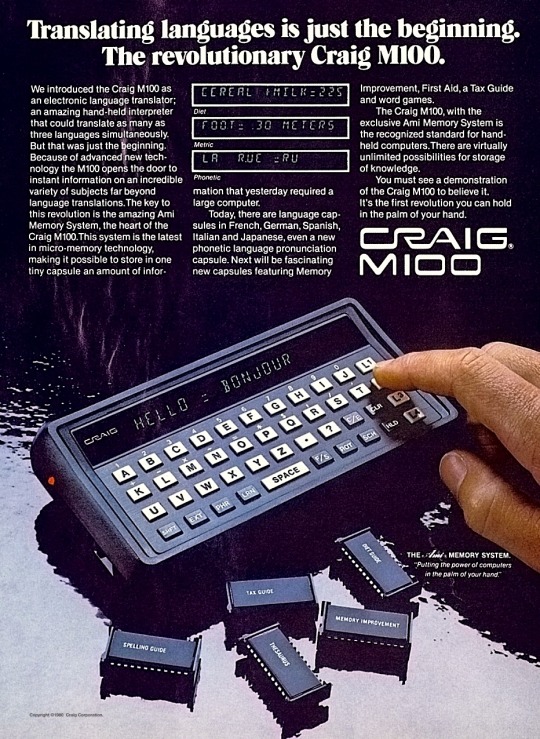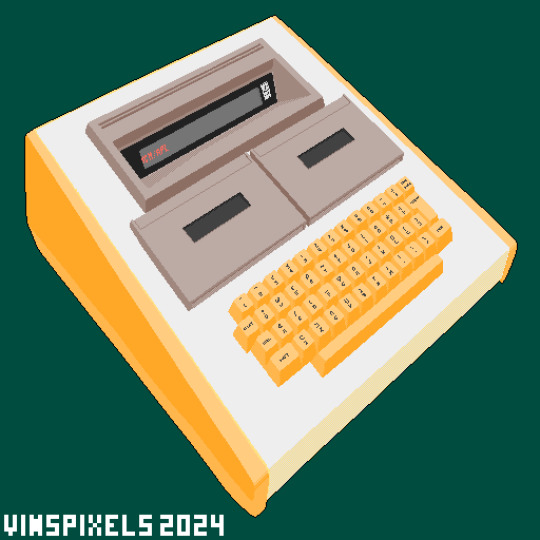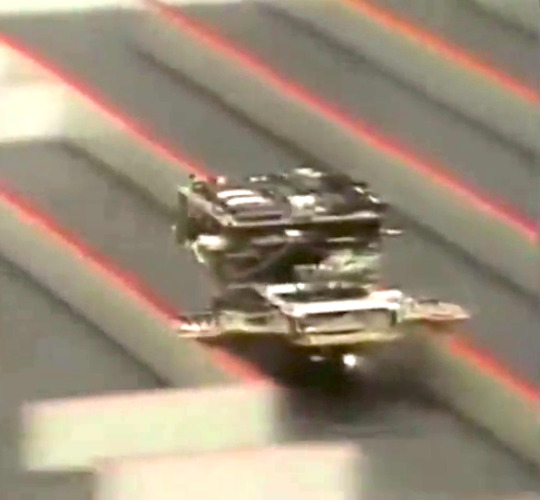#microcomputers
Explore tagged Tumblr posts
Text







🎄💾🗓️ Day 8: Retrocomputing Advent Calendar - Commodore PET 🎄💾🗓️
The Commodore PET (Personal Electronic Transactor) came out in 1977 and was among the earliest personal computers - featuring an all-in-one design with a keyboard, monochrome monitor, and cassette deck - all within a single chassis. Powered by an MOS Technology 6502 microprocessor running at 1 MHz, it had 4 KB of RAM and was expandable up to 96 KB in later models. The PET had Commodore BASIC stored in ROM, allowing users to write and execute programs directly. Its display supported text resolutions of 40×25 or 80×25 characters, using the PETSCII character set for semigraphic capabilities. While early models did not have sound, later versions included a basic beeper. PET's all-in-one design and user-friendly interface contributed to its popularity in education and business, and it sold approximately 219,000 units before its discontinuation in 1982.
Check out the wikipedia page for some extended history and great photos -
Have first computer memories? Post’em up in the comments, or post yours on socialz’ and tag them #firstcomputer #retrocomputing – See you back here tomorrow!
#retrocomputing#commodorepet#adventcalendar#vintagecomputers#personalcomputing#techhistory#1977tech#earlycomputers#commodore6502#petscii#computermuseum#technostalgia#oldschooltech#computingpioneers#classiccomputers#80scomputers#historyoftechnology#microcomputers#cassettedeck#basicprogramming#educationtech#businesscomputing#earlypcdesign#retrodesign#geekculture#nostalgiatech#techofthepast#vintagetech#allinonedesign
259 notes
·
View notes
Text

#Tech#Computer#RetroTech#Retro#RetroTechnology#RetroComputers#VintageComputer#RetroComputing#Magazine#ContelCodata#HighPerformance#UNIX#Microcomputers
82 notes
·
View notes
Text

I want to live in the world where Atari won the computer war, and every tower is still a massive molded plastic chassis with vents that you can only mod with cartridge cards the manufacturer designed for it.
...Wait no I don't, that would be a nightmare.
Cool aesthetic, though.
480 notes
·
View notes
Photo

For Sci-Fi Dolphin Saturday, here's an uncredited cover to MicroComputer magazine, 1983
4K notes
·
View notes
Text

TRS-80 Microcomputer News May 1983
Radio Shack's newest computer yet featured on the cover of this issue. In "View from the 7th Floor," Jon Shirley promised the company wasn't quite done yet with its introductions. One tangential part of the "Home Issue" could have been a description of the online games available on CompuServe.
100 notes
·
View notes
Text

UK 1982
82 notes
·
View notes
Text

「ラテカピュータ」
#@Dream_Library_#PC-2001#ラテカピュータ#Sharp#1979#vintage pc#hardware#tech#design#vintage#retro#pc#70s#1970s#CRT#Microcomputer Museum Japan
137 notes
·
View notes
Photo

An office worker logs addresses into a Data General computer at a direct-mail company in Boston, Massachusetts - via Mashable
64 notes
·
View notes
Text

If you’re thinking ‘Hey that looks like microcomputed tomography of an Asian gecko inside a 7mm egg’, well … you’d be spot on.
Photograph: Ekaterina Strounina
Australian Institute for Bioengineering and Nanotechnology
#ekaterina strounina#photographer#asian gecko#gecko#microcomputed tomography#australian institute for bioengineering and nanotechnology#micro photography#nature
22 notes
·
View notes
Text

Translating languages is just the beginning. The revolutionary Craig M100. Ad for the Craig M100 translator/microcomputer - 1980.
#vintage advertising#vintage ads#80s ads#80s advertising#the 80s#the 1980s#80s era#80s aesthetic#80s style#80s nostalgia#80s culture#craig#craig corporation#craig m100#vintage tech#vintage computers#vintage technology#vintage electronics#microcomputer#computers#retro tech#craig m100 translator#vintage electronic calculators#electronic calculators#vintage calculators#calculators
21 notes
·
View notes
Text






🎄💾🗓️ Day 15: Retrocomputing Advent Calendar - BBC Micro🎄💾🗓️⌨️🇬🇧
The BBC Micro was an 8-bit microcomputer introduced in 1981 by Acorn Computers under the BBC Computer Literacy Project of the UK, launched with a 6502A processor running at 2 MHz, supported 16 KB to 32 KB of RAM, and featuring a BASIC environment. The machine was versatile, having very good-for-its-time graphics and multi-colors. Expansion capability for educational and experimental use with an assortment of I/O ports, which included a 1 MHz bus, user port, and cassette interface.
The BBC Micro was known for its reliability and emphasis on teaching programming and computer science. The system software, Acorn MOS, was simple and intuitive. With peripherals such as floppy drives and second processors, it performed tasks well beyond its initial use and extended its lifetime by at least a decade or more.
The BBC Micro also pushed forward a lot of gaming and software since this open architecture inspired a thriving community of developers. It also played a big role in the development of the ARM architecture by Acorn Computers, which would change the way modern computers are made in years to come. The BBC Micro has a special place in computing history, which expanded education and brought computing to schools and society through the 1980s.
Have first computer memories? Post’em up in the comments, or post yours on socialz’ and tag them #firstcomputer #retrocomputing – See you back here tomorrow!
#retrocomputing#bbcmicro#vintagecomputers#8bit#oldcomputers#acorncomputers#bbccomputer#firstcomputer#computinghistory#nostalgia#80scomputing#classicrock#programminghistory#computerscience#technostalgia#microcomputers#homecomputers#computingeducation#armarchitecture#retrohardware#gaminghistory#8bitgaming#programmingbasics#cassetteinterface#computergraphics#educationalcomputing#vintagegaming#1980s#opensourcecomputing#historiccomputing
35 notes
·
View notes
Text

TSR-80 Microcomputer (1982)
#TSR-80 microcomputer#vintage computers#80s christmas#vintage video games#radio shack#vintage gaming#vintage PCs#80s arcade#tandy corporation#1980s#1982
379 notes
·
View notes
Text

MCM/70
A Canadian made Microcomputer from 1974.
145 notes
·
View notes
Text


EMI (1985) by Takayuki Uehiro, Fukuyama Microcomputer Club. Regional championships for the 1985 World Micromouse Contest were held around Japan. "The fifth Chugoku-Shikoku Regional Championship was held on August 4th (Sun) at NHK Fukuyama Broadcasting Station Studio 1, with 15 participants, including three from Tokyo. Among the Fukuyama Microcomputer Club members aiming for the world championship, it was a one-on-one battle between the NORIKO series of past champions Mugita and Uehiro's EMI, with the X-2 winning. The top five reached the finish line in 15-16 seconds, nearly half the time set in last year's national championship, and excited the crowd." – Mouse: Journal of the Japan Micromouse Association, September 1985.
At the finals of the 1985 World Micromouse Contest in Tsukuba, EMI gained third place, achieving a time of 20.36 seconds. "The third place "EMI" was made by Mr. Uehiro of the Fukuyama Microcomputer Club. It uses stepping motors for the two driving wheels and a DC motor for the single steering wheel, and a rotation counter is built into the steering wheel to record the distance traveled. The mouse weighs 1600g, which is by no means light, but the average speed for both the X1 and X2 is about 80cm per second." – Mouse: Journal of the Japan Micromouse Association, September 1985.
The video is an excerpt from "The first World Micromouse Contest in Tsubuka, Japan, August 1985 [2/2]."
#cybernetics#robot#micromouse#Fukuyama Microcomputer Club#1985#'85 World Micromouse Contest#maze solvers
29 notes
·
View notes
Text
Flashbacks to my third-grade English book that told us that the proper translation for a laptop is sylimikro. Lap microvawe. Our teacher did not accept kannettava tietokone as an answer. Lap microvawe.
#yes yes I know micro in this sense means small. as in microcomputer#but a nine-year-old does not know what the fuck micro means#they do know what a mikro is however. it's in the kitchen#no one in the history of finnish language has actually called a laptop a sylimikro. apparently us learning that term was essential.
17 notes
·
View notes
Text

TRS-80 Microcomputer News November 1982
New software for the Color Computer (which wasn't, however, a full implementation of the educational language Logo) featured in this issue. The cover happens to show a printer added to the system (with a familiar piece of graphical output visible in it), and the issue also happened to feature the latest iteration of Radio Shack's printer line.
#computer magazine cover#trs-80 microcomputer news#trs-80 color computer#color computer#dmp-100#women and computers#girls and computers
54 notes
·
View notes